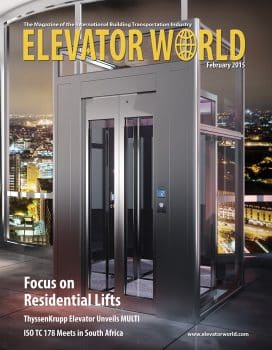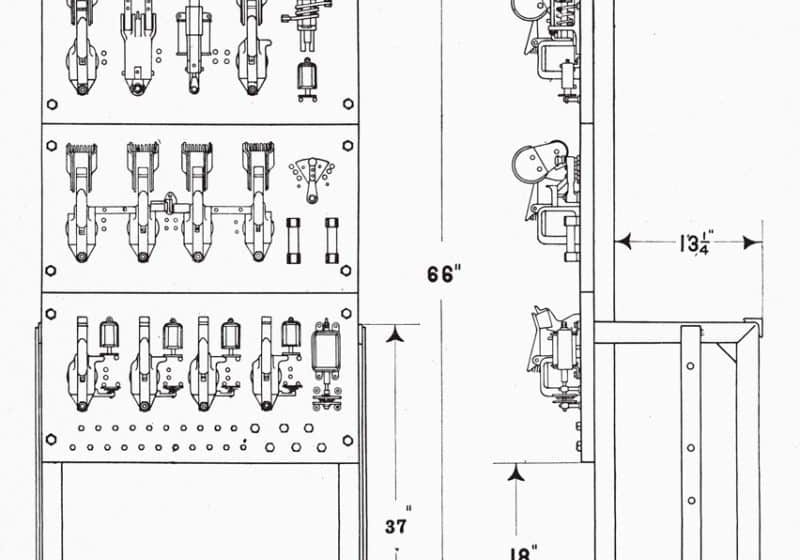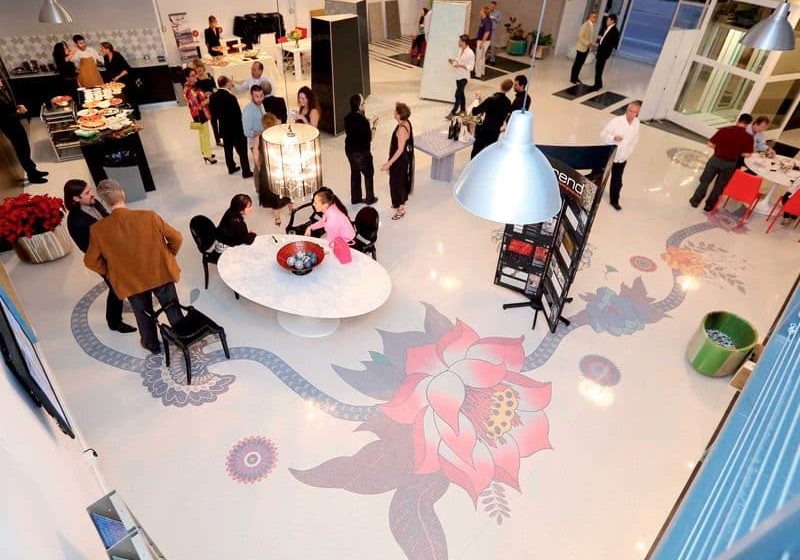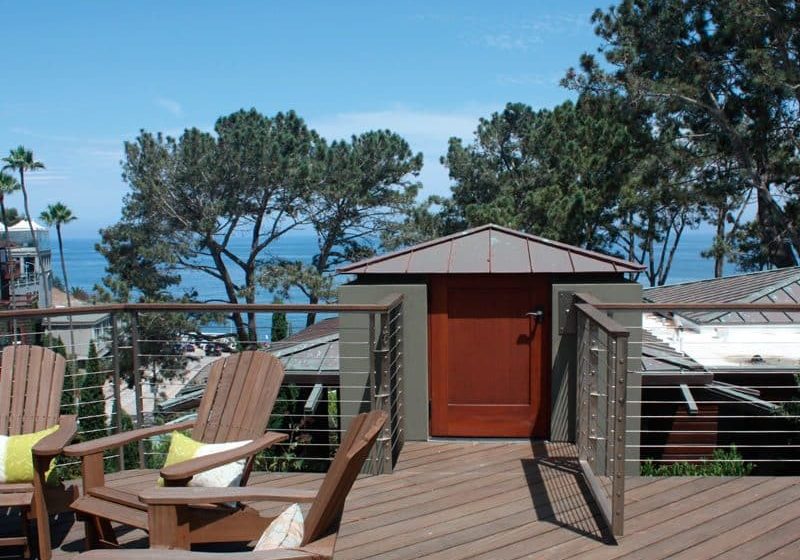ISO TC 178 Plenary Meeting in South Africa
Feb 1, 2015
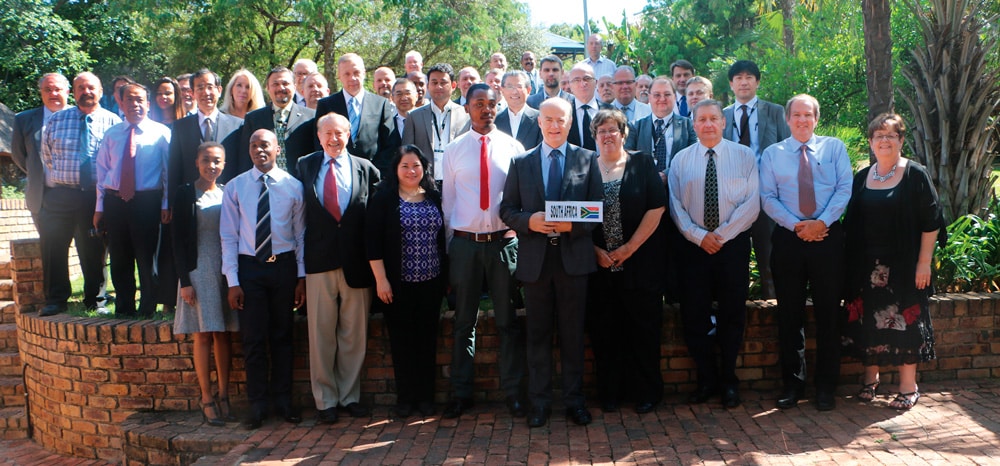
Lush Blooms in, around Pretoria herald productive meetings; “Big Five” spotted.
“Once you have tasted the waters of Africa, you will always be thirsty until you drink them again.” This old African saying has special meaning for your author, who was born and raised in South Africa and spent many formative years there. Your author left South Africa in 1976 at a time when apartheid was at its worst and the prospects for a peaceful resolution were dim, indeed. Having returned to South Africa on numerous occasions, your author is encouraged each time by the progress that has been made and the degree of reconciliation that has been achieved. This time was no exception, and the evidence of progress was present in all walks of life.
South Africa is a very beautiful country any time of year and particularly so in the springtime, as illustrated by the avenues of Jacaranda trees in full bloom that adorn the city and suburbs of Pretoria and Johannesburg. The rich purple blossoms glow in the brilliant sunshine, lending a sense of serenity to the environment. The exotic flora in the beautiful gardens of the Leribe Resort where the International Organization for Standardization (ISO) Technical Committee (TC) 178 Plenary Meeting was held on October 20-24, 2014, was a constant reminder that this is a very special place. The countryside was adorned by myriad multicolored wildflowers symbolizing the freshness of new growth, new energy and new hope in this once-tortured land.
The beauty of the flora is matched by the elegance and diversity of the fauna, as witnessed by the attendees, who took a day trip to the Pilansberg nature reserve near Pretoria. Among the many species of game and birdlife that frequent the park, several guests were lucky enough to see some of the “Big Five”: elephant, rhinoceros, buffalo, lion and leopard. They are so named as the prized trophies of hunters of bygone years but nowadays treasured as images on tourists’ cameras.
Welcome Reception
During the welcome reception at Leribe, Helen Temple, senior manager of Standards Development at the South African Bureau of Standards (SABS), which hosted the plenary, used the “Big Five” as a metaphor for some of the basic tenets of SABS mantra for standards development:
- Teamwork
- Listen to each other
- Speak up and share your views
- Commitment to the task ahead and fellow workers
- Dedication to the organization
Temple suggested these principles were applicable to the meetings and tasks before us. She indicated that one of the lessons learned in the new South Africa was that more is achieved by harmony and cooperation than by any one group dominating another. Cooperation often means compromise, and this leads to progress.
SABS was established by an Act of Parliament in 1945. An agency of the Department of Trade and Industry, it is the national institution for the promotion and maintenance of standards and quality. SABS maintains 6,500 national standards and represents South Africa in ISO and the International Electro-technical Commission (IEC). SABS was a founding member of ISO and currently holds the secretariat for SADCSTAN, the standardization body for the 14-nation Southern African Development Community.
Temple introduced and thanked the core team that planned and organized this major event: Bruno Isler, chair, SABS TC 1082; Peter Murray, member, TC 1082; Lerato Magalo, program manager, Engineering and Building, SABS; Patrick Qwabe, team leader, Mechanical, SABS; and Thembi Hlongwane, International Relations officer, SABS.
The welcome reception was also attended by Mohlakola Monyaki, a specialist from the South African Department of Labour (DoL), who explained that the DoL is the regulating authority responsible for the adoption and enforcement of safety codes. The DoL is also very involved with occupant health and safety in building structures, as well as worker safety during construction and maintenance activities. The elevator industry is a very important aspect of such activities, and international approaches to safety are of great interest.
Working Group Meetings
Preceding the Plenary Committee Meeting were: Working Group (WG) 4: Safety Requirements and Risk Assessment, convened by David McColl (Canada); WG 5: Escalator Safety Requirements, convened by Edip Kaci (Turkey); and WG 6: Evacuation and Lift Dimensions, convened by Ari Ketonen (Finland). The main purpose of these meetings was to continue the work assigned to the WGs, prepare updates on the status of the work and develop positions for presentation to the Plenary Committee.
Plenary Meeting
The Plenary Committee Meeting was opened in English and French on October 23 by Christian De Mas Latrie, chair of TC 178. He reminded the attendees that though English, French and Russian are official ISO languages, that this meeting would be conducted in English only. He also reminded the attendees that this was the 26th plenary meeting. While such meetings had been held in many parts of the world, this was the first time it was held in Africa. De Mas Latrie emphasized the fact that this meeting was very important, as South Africa is a major gateway to the African continent, which is becoming a significant player in the lift industry and will continue to grow in importance. He expressed his thanks to the SABS team for the professional organization of the event.
After welcoming attendees to South Africa, Magalo indicated SABS was very proud to host this meeting, the first in the Southern Hemisphere. She affirmed the commitment of SABS to ISO and thanked Isler and Murray for their hard work as volunteers, as well as the SABS staff. She also introduced Jacob Malatse, director, Electrical and Mechanical Engineering, DoL.
South Africa is a major gateway to the African continent, which is becoming a significant player in the lift industry and will continue to grow in importance.
Eva Contival, Secretary of TC 178, initiated the roll call of delegates to the meeting. There were 39 delegates from 15 countries and the Pacific Asia Lift and Escalator Association (PALEA). The chair presented a summary of TC 178 membership, marketing and key information. There are approximately 50 member countries, of which approximately 25 are “p” (voting) members. The largest annual volume of new-equipment installations is taking place in the Asia-Pacific area, while the largest installed base remains in Europe. The value of the world market for new equipment and service exceeds US$66 billion per annum.
ISO TC 178 presently comprises seven active working groups. TC 178 authored 33 published standards, of which five are under revision. Eight new standards are in the process of development. TC 178 maintains liaisons with 11 technical committees in ISO, IEC and other standards-developing entities.
Resolutions
The TC 178 Plenary Committee Meeting was very productive and resulted in lively discussion and debate. Twenty-eight resolutions were approved during the meeting, some of the more noteworthy of which are described below.
Risk Assessment and Performance-Based Standards
Resolutions were approved to confirm ISO 14798 Risk Assessment and Reduction Methodology, update references in ISO 22559-1 Global Essential Safety Requirements, and submit ISO DTS 22559-2 Global Safety Parameters and ISO DTR 22559-5 Convergence of Lift Requirements for approval. The first three documents are suitable for utilization in performance-based codes, such as ASME A17.7/CSA B44.7. The fourth document provides a comparison of code requirements for several safety components between major codes currently in use, including recommendations that will lead to the convergence of requirements.
Electrical Standards
Resolutions were also approved to fully harmonize ISO 22199 and ISO 22200 with CEN EN 12015 and EN 12016 so as to develop a single set of globally relevant electromagnetic compatibility (EMC) standards. Further resolutions were taken to compare the ISO and national standards for PESSRAL and PESSRAE, respectively, and document the comparison in revised versions of ISO 22201 and ISO 22201-2.
Guide Rails
Resolutions were approved to apply a standstill to the revision work on the ISO 7465 standard for elevator guide rails for the moment, as there is no demand for its modification. It was pointed out that there may be some errors in the standard. This will be investigated and, if necessary, will be used as a basis for the revision of the standard.
Prescriptive Standards for Lift Safety
Many major countries would prefer to have a prescriptive ISO standard, rather than the one currently in use. In support of this need, ISO TC 178 passed Resolution 341/2011 in Moscow in 2011. It is intended as a basis by which to study the development of an ISO standard based on EN 81, which is the most common standard in current use. In response to this resolution, WG 4 developed a proposal for a prescriptive standard, while providing for the needs of all users. This approach involves the creation of ISO 22559-X/Y based on EN 81-20/50 and (for the portions of the codes where the scopes overlap) the creation of ISO 22559-Z, which contains Part A: identification of specific requirements (“Section” and “Requirement” numbers only) for A17.1/B44 and Part B: specific requirements for BSLJ/JIS. All documents are to be cross-referenced and published simultaneously. In addition, an introduction will explain the process to be used in attaining equivalent safety to the A17.1/B44 and BSLJ/JIS codes for portions where the scopes overlap. A narrative explaining the proposal and a roadmap outlining the steps and timetable were developed by WG 4.
Based upon this proposal, ISO/TC 178 passed a resolution to launch a ballot to obtain approval of ISO TC 178 members of the roadmap, accompanying narrative and actions for ISO 22559-X, Y and Z.
Existing Lifts
Concern was expressed with the process of developing a standard for existing lifts. A resolution was thus approved to instruct WG 11 to verify and expand its member list and prepare a revised version of ISO PNP 18235 within 12 months. The revised draft shall include an annex explaining how the standard should be used to enhance safety of existing lifts in various areas. The ISO TC 178 secretariat will launch a call for experts on the TC level.
Chair and Conveners
A resolution was passed to reappoint Christian De Mas Latrie as chair of TC 178 for a further period of three years. Resolutions were also approved to reappoint McKee, McColl, Kaci, Ketonen, Robibero and Casteleyn as conveners of WGs 2, 4, 5, 6, 8 and 11, respectively.
Ian Todkill (PALEA) announced he is in the process of reducing his workload and will, thus, not be available to chair WG 10 in the future. The committee approved a resolution to thank Todkill for his hard work and dedication. A further resolution was approved to appoint Barry Blackaby (U.S.) to the position of convener of WG 10: Energy Standards.
Future Meetings
A discussion was held on the location of the next two plenary sessions. Chris Jones, head of the Australian delegation, gave a detailed presentation on behalf of the Australian Standards Association (ASA) offering to hold the next meeting in Sydney. Jones indicated that funding was already approved, and a venue had been arranged. Abhijit Dandekar, head of the Indian delegation, gave a brief presentation offering to hold the next meeting in New Delhi. The committee appreciated the fact that two viable offers had been made, and that there was so much interest in hosting future meetings. After considerable discussion, the committee approved a resolution to gratefully accept the proposal from the ASA to host ISO TC 178 and its WGs for its next plenary meeting on April 11-15, 2016, with the plenary starting on April 14 in Sydney. The Indian delegation graciously offered to host the subsequent plenary meeting in New Delhi. Based on this, the committee approved a further resolution to gratefully accept the proposal from the Bureau of Indian Standards to host ISO TC 178 and its working groups for its plenary meeting at the end of September 2017 in New Delhi.
Harmony at The Farm Inn
There were many opportunities for social contact and bonding throughout the week of the plenary and WG meetings. One of the highlights was a dinner held at The Farm Inn, a country hotel some distance from Pretoria. All attendees were invited by Dr. Sadhvir Bissoon, executive: Standards of SABS. The venue was beautiful and the cuisine superb. A traditional South African braaivleis (barbecue) was provided, and the group was given a hands-on lesson in African drum rhythms, as well as rhythmic handclapping and dance. It was amazing to see how quickly a diverse group from so many different cultures and backgrounds could bond and harmonize. Suffice it to say, all enjoyed the experience. This fun experience evoked some deeper thoughts, expressed by Malatse, who advocated that harmony has many forms: the harmony of nature as a whole, the harmony of people and nature and the harmony of people with people. From harmony comes partnership and progress!
Concluding Thoughts
When the chair finally closed the meeting, he commended the committee on the progress made. He pointed out that it was appropriate that bold steps with far-reaching consequences had been made in a place where a history of making monumental decisions exists.
Indeed, there was an atmosphere in the closing moments that this was not any ordinary meeting – as if everyone present had grown in ways they never imagined as a result of the warmth and spirit of South Africa. Your author, for one, having come and gone many times, knew that while this would be one of the hardest times to leave, something big had been accomplished. The words of Nelson Mandela come to mind: “Everyone can rise above the circumstances and achieve success if they are dedicated to and passionate about what they do!”
Get more of Elevator World. Sign up for our free e-newsletter.

